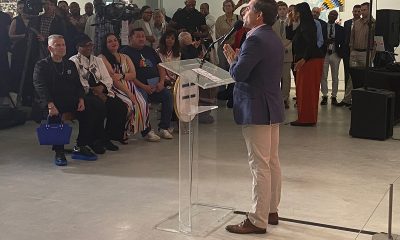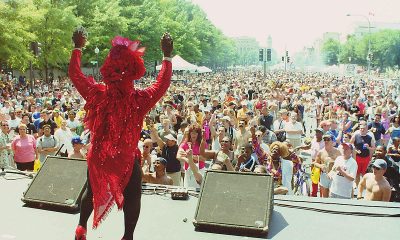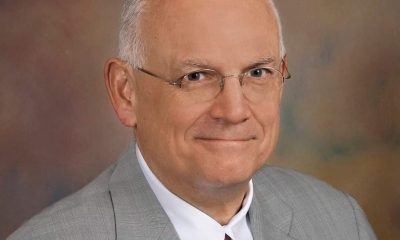a&e features
Liz architect creates a building that fits in and stands out
Annabelle Selldorf honors the past while creating vibrant new spaces


There aren’t many buildings in Washington that are named after a movie star.
Or use an early 20th century garage as modern office space.
Or frame upper-level windows with all the colors of the rainbow
Those are a few of the characteristics of Liz, the mixed-use building on 14th Street N.W. that was named after Elizabeth Taylor and houses the administrative offices of Whitman-Walker Health, a leading health care provider for the region’s LGBTQ community and people with HIV/AIDS. It also has street-level retail space, more offices and 78 apartments.
Creating a building that meets the needs of Whitman-Walker Health and other occupants was the job of Annabelle Selldorf, a prominent New York-based architect who served as the lead designer.
Selldorf, the head of Selldorf Architects, is known for her work with high-profile clients such as the Frick Collection and the Neue Galerie in New York, the Museum of Contemporary Art San Diego and the soon-to-open Rubell Museum in Miami. Liz is her first completed project in the District of Columbia and her first project anywhere for a health care-oriented client.
Her approach was to combine historic preservation and new construction to arrive at a single interconnected structure that both fits in with the surrounding area and stands out as a significant addition to it — a game changer in the cityscape and new front door for Whitman-Walker.
Experienced in blending old and new, Selldorf created a composition in which the new construction is set back or clearly distinguished from the two historic buildings that were preserved as part of the project, so it doesn’t upstage or loom over them.
The goal, she says, was to honor the past while creating new spaces that will enable the city to grow and strengthen Whitman-Walker for the future.
“I’m deeply humbled by having been given the opportunity” to work on the project, she said at the ribbon cutting. “It’s humbling because … this is for people, and if it isn’t for people who are belonging into this place, and if you are not welcoming to everybody, what is the meaning of being an architect?”
Andy Altman, one of the principals of Fivesquares Development, a real estate company that worked with Whitman-Walker, said he and his partners were delighted that Selldorf agreed to take on the project, given her reputation. He said Selldorf is known for work that can be both dignified and playful, that provides a pleasing juxtaposition of old and new, and that’s what his group believed 14th Street and Whitman-Walker needed.
“Annabelle Selldorf is a world-renowned architect who does amazing commissions,” he said at the opening. “We went to Annabelle … and said we want a work that is going to be beautiful, exquisite, bold but subtle, not something ostentatious but that will really be of world-class stature for our city. Annabelle was the choice, and we were thrilled that she would do it.”
Named after Elizabeth Taylor, an actress and early AIDS activist, Liz is a collaboration of Whitman-Walker and Fivesquares, a for-profit, socially conscious developer and contractor that also has its offices in the building.
The completed project, which was dedicated on Nov. 6, occupies an entire city block in the 1700 block of 14th Street, N.W., between R and Riggs streets.
Whitman-Walker, a non-profit with a long history of providing health care for the LGBTQ community and people with HIV/AIDS, owned the block and had used the corner building as the main entrance and waiting area for the Whitman-Walker Elizabeth Taylor Medical Center, which opened in 1993.
When the medical center moved to larger quarters two blocks away several years ago, that freed up space for Whitman-Walker to redevelop its property at 14th and R.
Under its partnership agreement with Fivesquares, Whitman-Walker remained the majority partner in the project, a rarity in collaborations of this kind. Altman says he believes it is “a model of urban regeneration” and “a model for non-profits nationally and what they can do to sustain their mission and serve their needs.”
The initial plan was to build new administrative offices for both Whitman-Walker and Fivesquares, while adding rental housing and street-level commercial space that would generate revenue for the joint venture and add life to the street. As the design evolved, the project gained another component, a cultural center and meeting place that will serve the community at large, especially the LGBTQ community.
Today, the ground floor is occupied by retail tenants and the soon-to-open Whitman-Walker Cultural Center. The second floor is occupied by Whitman-Walker Health, including administrative offices, health and legal services, public benefits and research programs. The third floor is shared by the Goethe-Institut, a German language school, and Fivesquares’ offices. Floors four to seven contain the apartments.
Born in Cologne, Germany, the daughter of architect Herbert Selldorf, Selldorf came to the United States as a young woman to study architecture at Pratt Institute in New York. After working for others, she started her own firm in 1988. She’s part of a small but growing roster of women architects who lead or co-lead design firms in the U.S., along with Jeanne Gang, Elizabeth Diller, Deborah Berke and Billie Tsien.
Selldorf’s firm specializes in designing buildings for art and education, and it has worked internationally on museums, galleries and other cultural projects. Her firm also designed the Sunset Park Materials Recovery Facility on the Brooklyn waterfront, an award-winning garbage recycling center that’s been a popular stop during the annual Open House architectural tours in New York. Critic Paul Goldberger once described her work as “a kind of gentle modernism of utter precision, with perfect proportions.”
Selldorf said in a phone interview that she had no previous connection to Whitman-Walker or Fivesquares but was intrigued when members of the development team approached her about the commission.
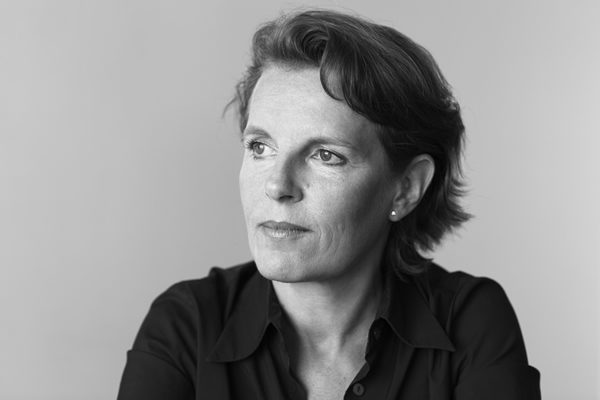
Although she isn’t gay, she said she admires what Whitman-Walker does (and what Fivesquares does) in Washington and could tell they would be the sort of architecturally savvy clients with whom she’s accustomed to working. She was also eager to take on a health care related project, something new for her practice. And although she never met Elizabeth Taylor, she is certainly a fan. “After seeing ‘Cat on a Hot Tin Roof,’” she said,” how could you not be?”
The development team was required by the city’s historic preservation office to save two buildings on the site, the corner structure at 14th and R, which was the front door and waiting room for Whitman-Walker’s Elizabeth Taylor Medical Center from 1993 to 2017 and a flower shop before that, and a midblock building known as the Belmont Garage, significant as an early local 20th century structure with an auto-related use. The team was allowed to demolish a third building on the block that wasn’t deemed historically or architecturally significant
Selldorf said the team sought to maximize the amount of new construction it could build on the site but didn’t want to overwhelm the structures targeted for preservation. Working with CORE architecture + design, the executive architect, Selldorf preserved and renovated the two historic buildings on site and added a 150,000-square-foot structure containing the residences, stores, offices and community space.
“We explored how much space the property would yield,” she said. “We ended with a very happy solution to fully utilize the building envelope and yet come up with something that makes a lot of sense.”
The completed development has what appears to be two new twin structures facing 14th Street, each rising seven stories. They are actually projecting sections of a large building that fills the whole block, containing retail and office space on the lower levels and apartments above.
Along 14th Street, the seven-story sections are separated by the low-rise Belmont Garage, which has been recycled as office space. At the corner of 14th and R, the new construction is set back from the street and frames the historic structure that had been the main entrance to the Elizabeth Taylor Medical Center before it was relocated.
The new construction does not mimic the older buildings on 14th Street. It has clean lines and is free of applied ornament, making it clear what is new and what has been preserved. It’s an optimistic building that is very much about urban rebirth and the co-existence of old and new.
Selldorf hesitates to put any stylistic labels on her design, saying only that she wanted to create a “well-proportioned, contemporary building that takes its cues from the neighborhood in terms of materials and proportioning and has an overall connection” with it
To help the new construction fit in, she said, she specified limestone and terra cotta for the exterior, materials that are common on older buildings in Washington. In an additional nod to Whitman-Walker’s history of serving the LGBTQ community, Selldorf framed the upper-level windows of the new structure with a pop of color.
There are 12 colors in all, and they’re created by a process of glazing the chamfered terra cotta window surrounds with a succession of hues, like a color wheel, working their way around the building. The colors can be seen as a reference to the rainbow flag. They’re also an effective way to animate the facades and indicate that this is a welcoming place for the LGBTQ community.
“It was really a playful gesture,” Selldorf said. “It all has to do with the composition of the facades … I wanted there to be a relationship between the limestone buildings along 14th Street, and then I thought there was an opportunity to have something that wasn’t quite so conservative and old-fashioned.
“I’ve always enjoyed working with terra cotta, so we came up with this color scheme that would go around the windows. It gives the building a kind of lively and friendly and welcoming appearance. The idea is that the colors would graduate into one another and no two colors would not harmonize with one another.”
Another sign of Selldorf’s desire to create a composition that fits in with its surroundings is that she restored the corner building to the appearance it had when it was a flower shop years ago, recreating projecting windows that make it possible to see in and for people inside to see out.
“The corner building was in very bad shape, and so I convinced the client to give us the opportunity to make it as good as it could be and maybe better than it ever had been,” she said.
That transparency represents a symbolic break from the days when many gay people were ‘in the closet’ or shunted out of sight, especially if they were sick. The new windows make the corner building more inviting, while recreating its original look.
These changes are reinforced by a people-friendly design for the outdoor space around the building, by Future Green Studios, that includes generous planting, new seating and public art that encourages people to linger at the corner. The intersection even has graphic ‘bump outs’ on the street surface that appear to narrow the road and increase the amount of space for pedestrians.
“Everything we do is trying to bring people together and create agreeable, open, transparent spaces,” Selldorf said. “It’s not just one specific thing. It’s sort of an idea about how the building represents a kind of openness in the landscape. I think that makes a big difference. It signifies to people that you are welcome there.”
One big decision that grew out of the design process was the idea of recycling the corner building as a cultural center for the LGBTQ community.
Whitman-Walker and Fivesquares didn’t originally plan to have a cultural center as a component of the development. According to Abby Fenton, chief external affairs officer, Whitman-Walker CEO Don Blanchon and others suggested that use as a way to add a new dimension to what Whitman-Walker could do on the block.
The idea is for the cultural center to serve as a flexible meeting and exhibit space that can accommodate a wide range of activities, including talks, readings, art shows and performances of interest to the LGBTQ community.
Seldorf donated her design services for the cultural center component of the project as a way of giving back to the community. Whitman-Walker recently hired a staff curator to coordinate activities and events, and the center is expected to be in full operation by early next year.
“I think they realized how much this corner matters to people in the community and to their specific constituents,” Selldorf said of Whitman-Walker. “This will be an ongoing public service. They became very excited to let their clients have a voice in that way. It’s really a fantastic attitude, and I am very excited to see how it will turn out.”
At the ribbon-cutting, D.C. Mayor Muriel Bowser praised the decision to combine new apartments and medical care with a place for cultural activities.
“Let this project be a reminder that housing, cultural space, and medical care are imperative to how this city moves forward,” she said.
Elsewhere in the project, the designers tried to make it clear which areas of the building are new construction and which parts are old. In some cases, brick walls are left exposed to show that an area is part of a historic building. Other spaces employ colorful lighting and contemporary touches to indicate the space is new. Perkins and Will was the interior designer for Whitman-Walker’s second-floor space.
Whitman-Walker also has an art program in which works by various artists have been put on display to enliven its setting. The organization also displays artifacts salvaged from previous Whitman-Walker locations as a tangible reminder of its history. The largest work of art is an outdoor sculpture on the corner, a temporary installation by Yinka Shonibare.
Above the retail space and offices, on floors four to seven, the apartments include studios and one- and two-bedroom units. Sixty-six are market rate and 12 are considered affordable housing.
On the east side of the block, the building steps back from the alley. The setbacks make it less overwhelming for the smaller townhouse structures across the alley, while creating terraces for the apartment residents on that side of the block.
Yet another sign of Selldorf’s desire to be respectful of Whitman-Walker’s history is that she insists the name of the building is pronounced correctly. She points out that it’s not The Liz building or Liz Taylor Building, but simply Liz.
“I wanted it to be not too institutionalized,” she explained. “If you have to give a building a name, it makes it much more immediate.”
a&e features
From Prohibition to Pride: Queering the District podcast reveals local LGBTQ history
The new podcast explores the hidden history and enduring impact of queer spaces in Washington, D.C.

On June 25, as Pride month inched toward its end, three queer creators launched an ambitious project to honor the spaces that built D.C.’s LGBTQ community—and connect them to today’s queer life. The first episode of their podcast, Queering the District, hit streaming platforms that day, aiming to spotlight what host and co-creator Abby Stuckrath calls “third places”: bars, clubs, and gathering spots that have served as hubs for queer life across the city.
Each episode of the 10-part series delves into a different piece of D.C.’s queer past—from landmark clubs to untold personal stories—told through the voices of drag legends, activists, DJs, historians, and patrons who lived it. The show also threads together personal experiences from today’s community, bringing the listener on an auditory journey from Prohibition-era speakeasies to contemporary nights out at places like As You Are or Saints & Sinners.
Abby Stuckrath, alongside her sibling Ellie Stuckrath, and producer Mads Reagan, make up the podcast’s creative team. A recent journalism graduate of American University, Abby told the Blade that her passion for queer storytelling began during college—and that D.C. itself played a defining role in shaping her queer identity.
“I went to American University. I graduated last year and studied journalism. When I was in school, I always wanted to focus on queer stories – especially in D.C., because I’m from Denver, Colorado, I’ve never lived in a place like this before. D.C. has always just kind of been a place I call home when it comes to my queer identity.”
But breaking into the media to tell those stories wasn’t easy. Stuckrath quickly learned that editorial support—and funding—for queer-focused projects is limited. So she decided to do it her own way.
“I kind of found out that if you want to tell stories, you kind of have to do it on your own– especially when it comes to queer stories. There’s not a lot of people begging for us to talk about queer people and to pay you for it. So I was like, ‘Okay, let’s just do it on my own.’”
The idea for the podcast first took root in conversations with Ellie, Abby’s sibling and biggest supporter. Ellie had also moved to D.C. to find more space to explore and express their queer and gender identities. Together, the two began shaping a vision that would combine storytelling, sound design, and grassroots community input.
“I was like, ‘I don’t know what exactly I want to do yet, but I want it to be queer, and I want it to be about D.C., and it’s going to be called Queering the District, and we’re going to find out what that means.’ And Ellie is my biggest supporter, and my best friend. And they were like, ‘Hell yeah. Like, let’s do this.’ And so we decided to just do it together.”
The name stuck—and so did the mission. The team began researching queer D.C. history and found a city overflowing with stories that had rarely been documented, especially in mainstream archives.
“We started looking up the history of queer culture in D.C., and it kind of just clicked from there,” Stuckrath said. “I did not know anything about how rich our history is in the city until one Google search, and then I just kept learning more and more. I was kind of pissed because I studied gender studies in school in D.C. and didn’t learn shit about this.”
Season one focuses on the role of third places—non-work, non-home spaces where queer people could gather, exist fully, and build community.
“Third places have always been the epicenter of queer life… places outside of just your own personal home, because sometimes that isn’t a safe place. And of course, the work most commonly in the past and still today, isn’t a safe place for queer people to be full of themselves. So like, bars were the first place for queer people to really thrive and meet each other.”
To make the show participatory, Queering the District includes a twist: a voicemail line where anyone can call in and share a memory or question. The team calls the phone “Fifi”—a nod to the kind of retro guestbooks often used at weddings, but reimagined for queer nightlife and history.
“We wanted to find a way for people to share their stories with us anonymously… so even though we start in Prohibition, we wanted to connect it to now—like, those people who were singing jazz to each other in a white queer bar are connected to you singing karaoke on a Sunday night at your favorite gay bar. We’re all interconnected by this third place of queer bars in D.C.”
Those connections are emotional as well as historical. While building the series, one realization hit Stuckrath particularly hard: the immense loss of queer spaces in D.C., especially in neighborhoods that have since been heavily redeveloped.
“Every time I go to a Nats game, I think about, well, this just replaced five gay bars that used to be here. It used to be the home of Ziegfeld’s… Tracks, which was almost 2,000 square feet, with a volleyball court in the back, a fire pit, and iconic light show. I just didn’t know that we had that, and it made me sad for the queer elders that are in our city now who walk the streets and don’t see all those places they used to call home.”
That sense of loss—alongside the joy and resilience of queer community—is what the show aims to capture. As the podcast continues, Abby hopes it serves as both a celebration and an educational tool, especially for young LGBTQ people arriving in D.C. without realizing the queer foundations they’re walking on.
“D.C. is a unique city, and specifically young queer people who are hoping to move to the city—to know that you’ve got to know your history to be here. I hope this serves as an easier way for you to consume and learn about queer history, because queer history defines how we move in life.”
And for all the voices still left out, Abby is clear: this podcast is an open door, not a final word.
“This is a perfectly imperfect podcast. We should just be a starting point. We shouldn’t be the ending point.”
New episodes of Queering the District drop every Wednesday on all major platforms.
a&e features
Doug Spearman takes his chance
‘Noah’s Arc: The Movie’ debuted on Paramount+ last month

There’s no question that when Patrik-Ian Polk’s series “Noah’s Arc” premiered on Logo 20 years ago, it was a groundbreaking creation. The story of a group of Black gay men and their wonderful friendship. The titular arc was that of the cute main character, Noah (Darryl Stephens), and his close-knit circle of friends, including Chance played by gay actor Doug Spearman. This compelling and loving fraternity may, in fact, be what brought viewers back repeatedly, including a 2008 movie, “Noah’s Arc: Jumping the Broom,” as well as the 2020 “Noah’s Arc” short, and now, a new full-length feature “Noah’s Arc: The Movie,” debuting on Paramount+ on June 20. In the movie, filled with equal measures of laughs and tears, Chance, who has faced a devastating loss, finds his dependable friends there, ready to support and comfort him at a moment’s notice. I had the pleasure of speaking with Spearman the morning of the streaming premiere of “Noah’s Arc: The Movie.”
WASHINGTON BLADE: Doug, since the early 2000s, when the “Noah’s Arc” series premiered on Logo, you have been playing the character of Chance, including in the latest installment, “Noah’s Arc: The Movie.” What was it about Chance that appealed to you as an actor?
SPEARMAN: When Patrik (-Ian Polk) called me to ask me to play him (Chance), I was at JFK airport in the baggage claim, waiting for a suitcase. He explained what the part was. The thing that stuck out to me was the fact that Chance was in a long-term relationship with another Black man. And, they had a child; they had a 4-year-old daughter named Kenya. I had never seen two Black gay men raise a child on TV before. I thought it was the most revolutionary thing I’d ever seen. I immediately thought I’ve got to do this because that was something nobody had seen. I thought it was incredibly important to take the part.
BLADE: “Noah’s Arc: The Movie” was, once again, written and directed by Patrik-Ian Polk, who you just mentioned, is the creator of the entire franchise. What’s the secret to your long-standing working relationship?
SPEARMAN: [Laughs] the whole team, all of us, are like a band of brothers. We fight like brothers, we come together like brothers, we hash things out, we talk, because we’re all very different from our characters. I think the challenge of playing these guys and then uplifting these men, playing a part, especially something written by Patrik, is like solving a math equation. There’s always a challenge that’s enjoyable for me as an actor: to try to find out what it is that Patrik wants, and then how do I do it.
BLADE: I think you do a very good job of it.
SPEARMAN: Thank you very much
BLADE: In the years between “Jumping the Broom” and the new full-length movie, many changes have occurred, and the story addresses some of them, including gay widowhood, which is something that the aging community is now confronting, as well as mental health issues. Please say a few words about how you approached those subjects in the new movie.
SPEARMAN: I had a lot of loss in my life, right before we started shooting. Two months before we started shooting the first series, my mother died. I was going through the grief process through that whole first season. Since then, I’ve lost a lot of people in my life. In fact, when we started shooting the second season, the second week we were shooting, my ex died of a heart attack. I was having to fold that into what I was doing with my life on the set and off the set. You’ve got to show up and you’ve got to do your work. The first two seasons of “Noah’s Arc” are always tinged with the memory of grief. So, when I had to deal with the death that Chance faces (in the new movie), which is a significant death in his life, it wasn’t that hard to reach back, especially the scene in the graveyard. It was something that I unfortunately could pull from personal experience.
BLADE: Shifting gears, the movie features delightful cast surprises, including Jasmine Guy and TS Madison. Did you have a chance to interact with either or both when they were on set?
SPEARMAN: No, I didn’t have any scenes with Jasmine, and I missed her. I wish I had gotten to see her because I actually got to direct Jasmine for a CBS promo shoot for “Queen,” back in the early ‘90s. I had a huge crush on her when she was on “A Different World.” So, I really would have liked to reconnect. But TS and I got to see each other every day because I was in all her scenes. It was extraordinary being around somebody like that. That is one outspoken woman!
BLADE: Even though Beyoncé never makes an appearance in the movie, there’s a lot of talk about her. Would you say you are a Beyoncé fan?
SPEARMAN: Yes! I’m breathing! Yes, I’m a Beyoncé fan. I actually got the chance to meet her. I knew her mom. Her mom was extraordinary to me. She is in the second movie I directed. She also gave us a wedding gown to use in the very first scene of the movie. That family is extraordinarily important to me. Not only just to be a fan, but to be somebody who’s gotten to know them and work with them and see how hard they work. I don’t think anybody works as hard as Tina or Beyoncé.
BLADE: There was a recent news item about gay actor Benito Skinner of the Amazon Prime series “Overcompensating” being told not to bother auditioning for straight roles. As an out actor yourself, how important do you think it is for queer characters to be portrayed by queer actors, and vice versa?
SPEARMAN: Being queer is a multifaceted identity. There’s no one kind of queer person. I think finding the best actor that’s your first circle of casting. I think one of the joys about being an actor is that you get to play different parts. I play straight guys all the time. Dads and husbands and things like that. I think a lot of people are told not to do it. In fact, I wouldn’t be Chance if the actor who was originally cast as Chance hadn’t been pulled out of the series by his agents because they didn’t want him to play a gay character.
BLADE: That’s amazing! Thank you for sharing that. Without giving away too much, the ending of the movie is a little ambiguous, even ending with a question mark. If there was a “Noah’s Arc: The Movie” sequel, would you come back for that?
SPEARMAN: Yeah! A lot of it would depend on what Chance’s journey is going to be like. Patrik and I have conversations like that all the time. He’s very interested and supportive of input. I hope I would be, as we all would be, part of the creative growth with these characters. They live in Patrik’s head, and he writes them, but we’re the ones who have to flesh them out. It’s a conversation, it’s always a conversation.
BLADE: You are currently performing in Molière’s “The Imaginary Invalid” as part of the New Orleans Shakespeare Festival at Tulane. What has this experience been like for you?
SPEARMAN: It’s extraordinary! I started on stage when I was seven. There’s nothing like working with a live audience and having that immediacy. I’m working with an extraordinarily talented cast in a really great play, and I have some of the best scene partners I could ever want.
BLADE: Are there any upcoming film or TV projects you’d like to mention?
SPEARMAN: I’m still a writer, and I’m still a director, and I’ve still got scripts that I would like to make. I have a little something that’s a cross between “Treme” and “Bridgerton” that I want to do. I’m always trying to figure out what the next thing is.
a&e features
Visit Cambridge, a ‘beautiful secret’ on Maryland’s Eastern Shore
New organization promotes town’s welcoming vibe, LGBTQ inclusion
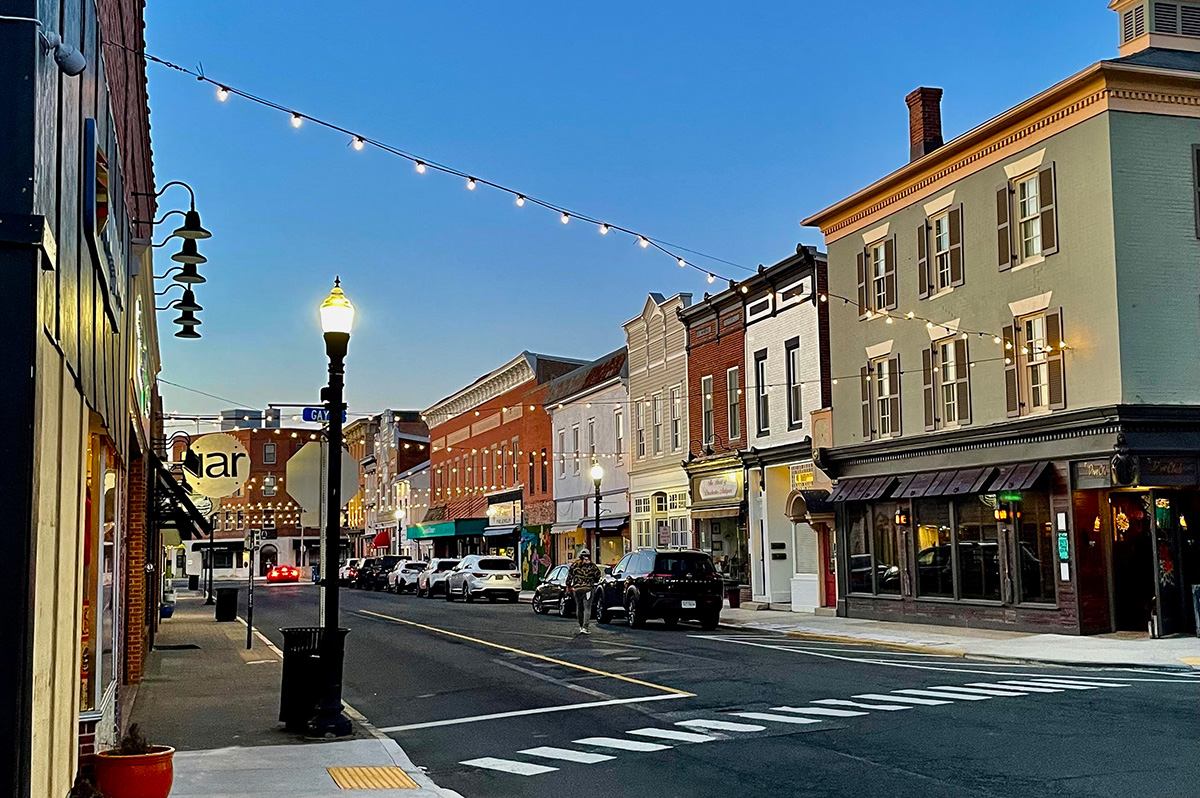
CAMBRIDGE, Md. — Driving through this scenic, historic town on Maryland’s Eastern Shore, you’ll be charmed by streets lined with unique shops, restaurants, and beautifully restored Victorian homes. You’ll also be struck by the number of LGBTQ Pride flags flying throughout the town.
The flags are a reassuring signal that everyone is welcome here, despite the town’s location in ruby red Dorchester County, which voted for Donald Trump over Kamala Harris by a lopsided margin. But don’t let that deter you from visiting. A new organization, Proudly Cambridge, is holding its debut Pride event this weekend, touting the town’s welcoming, inclusive culture.
“We stumbled on a beautiful secret and we wanted to help get the word out,” said James Lumalcuri of the effort to create Proudly Cambridge.
The organization celebrates diversity, enhances public spaces, and seeks to uplift all that Cambridge has to share, according to its mission statement, under the tagline “You Belong Here.”
The group has so far held informal movie nights and a picnic and garden party; the launch party is June 28 at the Cambridge Yacht Club, which will feature a Pride celebration and tea dance. The event’s 75 tickets sold out quickly and proceeds benefit DoCo Pride.
“Tickets went faster than we imagined and we’re bummed we can’t welcome everyone who wanted to come,” Lumalcuri said, adding that organizers plan to make “Cheers on the Choptank” an annual event with added capacity next year.
One of the group’s first projects was to distribute free Pride flags to anyone who requested one and the result is a visually striking display of a large number of flags flying all over town. Up next: Proudly Cambridge plans to roll out a program offering affirming businesses rainbow crab stickers to show their inclusiveness and LGBTQ support. The group also wants to engage with potential visitors and homebuyers.
“We want to spread the word outside of Cambridge — in D.C. and Baltimore — who don’t know about Cambridge,” Lumalcuri said. “We want them to come and know we are a safe haven. You can exist here and feel comfortable and supported by neighbors in a way that we didn’t anticipate when we moved here.”
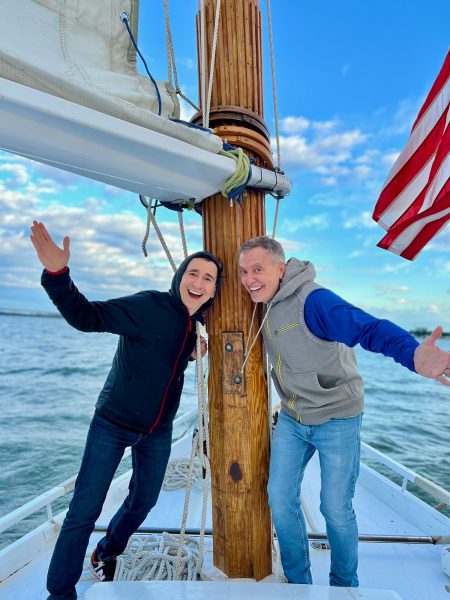
Lumalcuri, 53, a federal government employee, and his husband, Lou Cardenas, 62, a Realtor, purchased a Victorian house in Cambridge in 2021 and embarked on an extensive renovation. The couple also owns a home in Adams Morgan in D.C.
“We saw the opportunity here and wanted to share it with others,” Cardenas said. “There’s lots of housing inventory in the $300-400,000 range … we’re not here to gentrify people out of town because a lot of these homes are just empty and need to be fixed up and we’re happy to be a part of that.”
Lumalcuri was talking with friends one Sunday last year at the gazebo (affectionately known as the “gayzebo” by locals) at the Yacht Club and the idea for Proudly Cambridge was born. The founding board members are Lumalcuri, Corey van Vlymen, Brian Orjuela, Lauren Mross, and Caleb Holland. The group is currently working toward forming a 501(c)3.
“We need visibility and support for those who need it,” Mross said. “We started making lists of what we wanted to do and the five of us ran with it. We started meeting weekly and solidified what we wanted to do.”
Mross, 50, a brand strategist and web designer, moved to Cambridge from Atlanta with her wife three years ago. They knew they wanted to be near the water and farther north and began researching their options when they discovered Cambridge.
“I had not heard of Cambridge but the location seemed perfect,” she said. “I pointed on a map and said this is where we’re going to move.”
The couple packed up, bought a camper trailer and parked it in different campsites but kept coming back to Cambridge.
“I didn’t know how right it was until we moved here,” she said. “It’s the most welcoming place … there’s an energy vortex here – how did so many cool, progressive people end up in one place?”
Corey van Vlymen and his husband live in D.C. and were looking for a second home. They considered Lost River, W.Va., but decided they preferred to be on the water.
“We looked at a map on both sides of the bay and came to Cambridge on a Saturday and bought a house that day,” said van Vlymen, 39, a senior scientist at Booz Allen Hamilton. They’ve owned in Cambridge for two years.
They were drawn to Cambridge due to its location on the water, the affordable housing inventory, and its proximity to D.C.; it’s about an hour and 20 minutes away.
Now, through the work of Proudly Cambridge, they hope to highlight the town’s many attributes to residents and visitors alike.
“Something we all agree on is there’s a perception problem for Cambridge and a lack of awareness,” van Vlymen said. “If you tell someone you’re going to Cambridge, chances are they think, ‘England or Massachusetts?’”
He cited the affordability and the opportunity to save older, historic homes as a big draw for buyers.
“It’s all about celebrating all the things that make Cambridge great,” Mross added. “Our monthly social events are joyful and celebratory.” A recent game night drew about 70 people.
She noted that the goal is not to gentrify the town and push longtime residents out, but to uplift all the people who are already there while welcoming new visitors and future residents.
They also noted that Proudly Cambridge does not seek to supplant existing Pride-focused organizations. Dorchester County Pride organizes countywide Pride events and Delmarva Pride was held in nearby Easton two weeks ago.
“We celebrate all diversity but are gay powered and gay led,” Mross noted.
To learn more about Proudly Cambridge, visit the group on Facebook and Instagram.
What to see and do
Cambridge, located 13 miles up the Choptank River from the Chesapeake Bay, has a population of roughly 15,000. It was settled in 1684 and named for the English university town in 1686. It is home to the Harriet Tubman Museum, mural, and monument. Its proximity to the Blackwater National Wildlife Refuge makes it a popular stop for birders, drawn to more than 27,000 acres of marshland dubbed “the Everglades of the north.”
The refuge is walkable, bikeable, and driveable, making it an accessible attraction for all. There are kayaking and biking tours through Blackwater Adventures (blackwateradventuresmd.com).
Back in town, take a stroll along the water and through historic downtown and admire the architecture. Take in the striking Harriet Tubman mural (424 Race St.). Shop in the many local boutiques, and don’t miss the gay-owned Shorelife Home and Gifts (421 Race St.), filled with stylish coastal décor items.
Stop for breakfast or lunch at Black Water Bakery (429 Race St.), which offers a full compliment of coffee drinks along with a build-your-own mimosa bar and a full menu of creative cocktails.
The Cambridge Yacht Club (1 Mill St.) is always bustling but you need to be a member to get in. Snapper’s on the water is temporarily closed for renovations. RaR Brewing (rarbrewing.com) is popular for craft beers served in an 80-year-old former pool hall and bowling alley. The menu offers burgers, wings, and other bar fare.
For dinner or wine, don’t miss the fantastic Vintage 414 (414 Race St.), which offers lunch, dinner, wine tasting events, specialty foods, and a large selection of wines. The homemade cheddar crackers, inventive flatbreads, and creative desserts (citrus olive oil cake, carrot cake trifle) were a hit on a recent visit.
Also nearby is Ava’s (305 High St.), a regional chain offering outstanding Italian dishes, pizzas, and more.
For something off the beaten path, visit Emily’s Produce (22143 Church Creek Rd.) for its nursery, produce, and prepared meals.
“Ten minutes into the sticks there’s a place called Emily’s Produce, where you can pay $5 and walk through a field and pick sunflowers, blueberries, you can feed the goats … and they have great food,” van Vlymen said.
As for accommodations, there’s the Hyatt Regency Chesapeake Bay (100 Heron Blvd. at Route 50), a resort complex with golf course, spa, and marina. Otherwise, check out Airbnb and VRBO for short-term rentals closer to downtown.
Its proximity to D.C. and Baltimore makes Cambridge an ideal weekend getaway. The large LGBTQ population is welcoming and they are happy to talk up their town and show you around.
“There’s a closeness among the neighbors that I wasn’t feeling in D.C.,” Lumalcuri said. “We look after each other.”
-
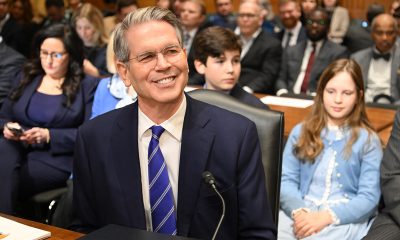
 Federal Government2 days ago
Federal Government2 days agoTreasury Department has a gay secretary but LGBTQ staff are under siege
-
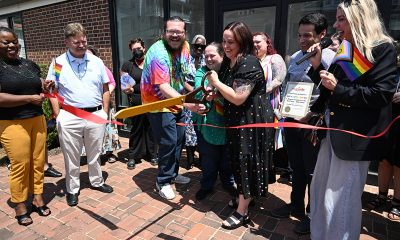
 Virginia2 days ago
Virginia2 days agoDefying trends, new LGBTQ center opens in rural Winchester, Va.
-

 District of Columbia1 day ago
District of Columbia1 day agoGay GOP group hosts Ernst, 3 House members — all of whom oppose Equality Act
-

 Opinions3 days ago
Opinions3 days agoUSAID’s demise: America’s global betrayal of trust with LGBTQ people

